Hasegawa 1/700 IJN Kako
|
KIT #: |
3346 |
|
PRICE: |
29.00 Euros |
|
DECALS: |
Yes |
|
REVIEWER: |
Frank Spahr |
|
NOTES: |
|
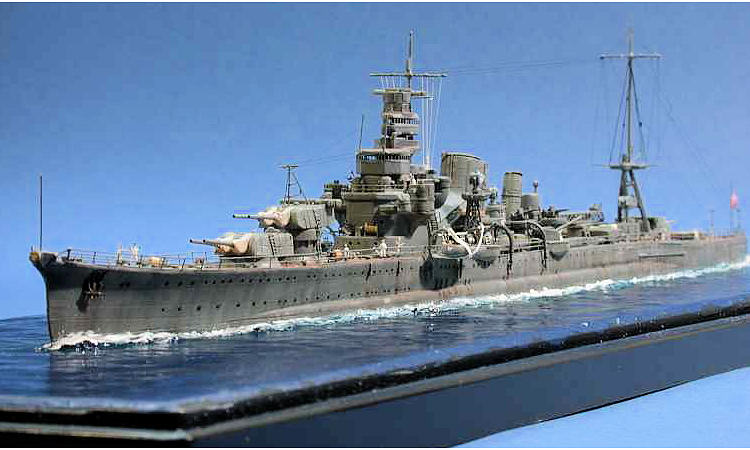
The
heavy cruiser IJN Kako was built at the Kawasaki´s Kobe shipyard from 1922-26.
Her design preceded the Washington Naval Treaty. She and her sister Furutaka
originally were meant to be fleet scouts with an emphasis on speed. The original
main armament consisted of six 20 cm guns in single mounts. The two remaining
ships of the class, Aoba and Kinugasa, were completed to a modified design with
three twin 20 cm turrets. After fleet service and action off China, Kako was
heavily reconstructed in 1936-7. Like other Japanese ships, her stability had
proved to be insufficient; in the reconstruction, she received
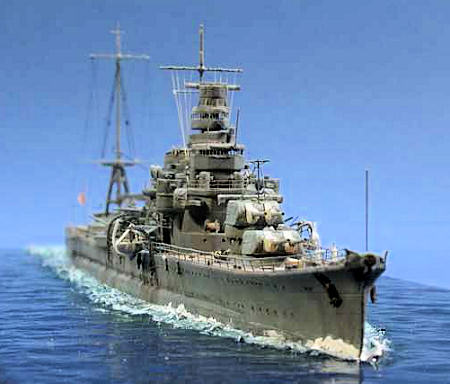 new
machinery, torpedo bulges plus similar twin turrets for the main armament as her
later sisters. The aircraft hangar was removed, rotating torpedo launchers were
fitted, and the AA fit was augmented.
new
machinery, torpedo bulges plus similar twin turrets for the main armament as her
later sisters. The aircraft hangar was removed, rotating torpedo launchers were
fitted, and the AA fit was augmented.
Kako started WW2 with the 6th
cruiser division. She took part in the invasion of Guam and the second attack at
Wake. Her next deployments led her to Rabaul, Kavieng, the Solomons, New Guinea,
virtually all the focal points of the Japanese advance. She remained unharmed at
the Battle of the Coral Sea, yet ran aground soon after and had to be repaired
at Kure. After her return, she was deployed with the 8th
fleet operating at the Solomons, New Britain and New Ireland.
During
the night from 8 to 9 August, 1942, Kako and her three abovementioned sisters,
together with three other cruisers and one destroyer, surprised a group of
Allied cruisers and destroyers covering the landings at Guadalcanal. The Battle
of Savo Island was an overwhelming Japanese success; four heavy allied cruisers
were lost, with no Japanese vessels lost. Ironically, Kako was herself lost the
day after her greatest triumph. The four heavy cruisers of the 6th
cruiser squadron were returning unescorted to Kavieng when they were sighted by
the American submarine S-44. At 0708 on 10 August, 1942, three torpedoes hit
Kako, which sank soon after with the loss of 34 crew members.
Hasegawa´s kit is one of their more recent entries in the Waterline series,
replacing an older kit. Hence overall detail is rather fine and the model will
look quite convincing if built OOB. Some items like
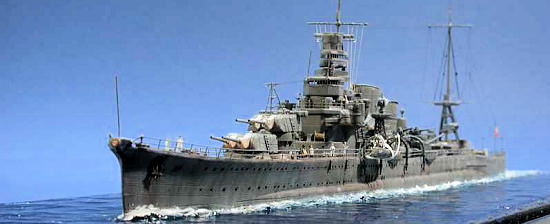 the
cranes and catapults mark the limits of injected plastic technology; replacing
them with items from today´s extensive aftermarket will visibly improve the
model´s overall impression. I for one do not use aftermarket items just for the
sake of using them, but only if I see an improvement over the kit part.
the
cranes and catapults mark the limits of injected plastic technology; replacing
them with items from today´s extensive aftermarket will visibly improve the
model´s overall impression. I for one do not use aftermarket items just for the
sake of using them, but only if I see an improvement over the kit part.
I used the Gakken book on the
class as my main reference; it contains extensive images of a 1:100 scale model
that to me are in many cases more helpful than original reference images. I
still had the GMM PE set for IJN cruisers and destroyers, and utilized it where
appropriate. Machined brass barrels for the primary and secondary armament were
obtained from ABER and Lion Roar. The aircraft catapult was replaced by the
excellent Lion Roar PE
version. The model was placed in a Trumpeter Display
Box.
I started by assembling the
hull and the deck, which displayed an excellent fit. According to instructions,
some deck fittings were removed; the scuttles were drilled a bit deeper with a
small burr. I was soon able to paint the hull and deck. Kako´s paint scheme
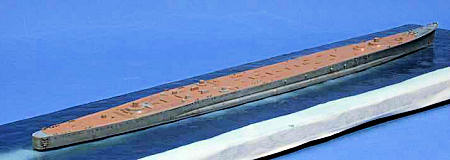 was very
simple, with Kure Grey over all, save the linoleum-coated decks. I used JPS
acrylics which spray and brush equally nicely and are easily touched up. To
highlight hull details, an oil wash was used. For the wash, I mix artist´s oil
paints and Humbrol thinner – this mixture works fine and does not harm my
acrylics. Some gentle drybrushing with grey oil paint further accentuated
details. I also used this paint to highlight the fastening strips for the
linoleum decks. Even though they were made from brass, I wouldn´t want to
use brass paint in this small scale.
was very
simple, with Kure Grey over all, save the linoleum-coated decks. I used JPS
acrylics which spray and brush equally nicely and are easily touched up. To
highlight hull details, an oil wash was used. For the wash, I mix artist´s oil
paints and Humbrol thinner – this mixture works fine and does not harm my
acrylics. Some gentle drybrushing with grey oil paint further accentuated
details. I also used this paint to highlight the fastening strips for the
linoleum decks. Even though they were made from brass, I wouldn´t want to
use brass paint in this small scale.
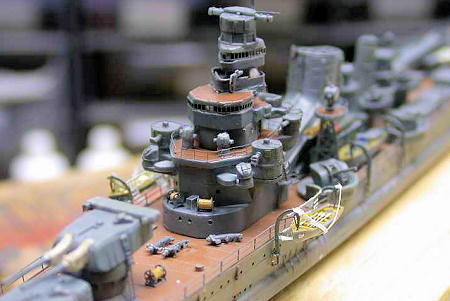
I
started the base at this stage already. I wanted to show Kako right before her
loss, gently steaming through a deceptively calm sea. I started with masking the
edges of the base. Then the base was painted with blue wall paint with a large
brush in a stippling motion, to give it some texture. After drying, a cardboard
template I had made of the model´s waterline base plate was fixed on the base .
Now I was able to apply colour to the base using my airbrush and various shades
of acrylics, aiming a a lighter and greenish-white hue around the ship. When I
was satisfied, the base was sealed with several coats of lacquer-based clear
gloss from a rattle can. This resulted in a surface that reflects the light
almost like water. Water effects were sculpted using gloss clear acrylic gel and
drybrushing with artist´s oils.
Construction
of the ship continued in various subassemblies. Generally speaking, I tried to
achieve a matching and credible level of detail. Oversized splintershields were
removed and replaced by CA-infused paper, a material which was also used on
additional platforms. PE watertight doors and inclined and vertical ladders were
added, molded-in bridge windows were replaced by PE ladder stock. Primary and
secondary gun barrels were replaced by turned brass items. The nicely molded
funnels were merely highlighted by washing and drybrushing.
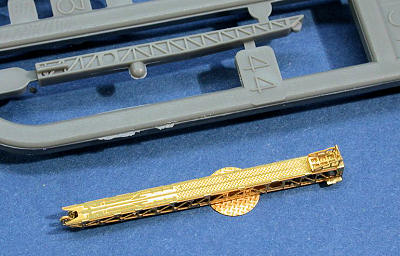 There
are some shipboard items which dramatically profit from using PE; in this case
the triangular searchlight towers and the aircraft crane from the GMM set and
the Lion Roar catapult are the most visible improvements. The catapult shows the
serious progress that has been made in PE parts over the last years, if compared
to the GMM item. Its biggest advantage is that it is actually buildable despite
its intricacy, something which does not apply to all PE parts currently offered.
There
are some shipboard items which dramatically profit from using PE; in this case
the triangular searchlight towers and the aircraft crane from the GMM set and
the Lion Roar catapult are the most visible improvements. The catapult shows the
serious progress that has been made in PE parts over the last years, if compared
to the GMM item. Its biggest advantage is that it is actually buildable despite
its intricacy, something which does not apply to all PE parts currently offered.
The
s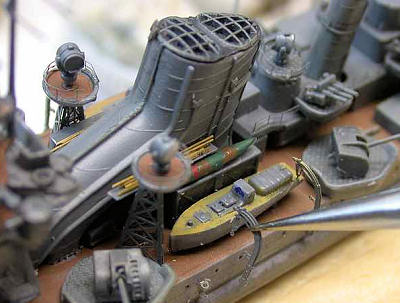 hip´s
boats and AA guns were taken from the generic equipment sprue of the Waterline
series. Properly painted they looked quite all right to me. I skipped the
seaplanes. One of Kako´s planes had been lost prior to the battle, the other had
been landed at the eve of the battle. I just added spare floats and wings which
are stored at the funnel and near the flight deck. Their green and brown camo
scheme offers some welcome contrast to the overall grey scheme.
hip´s
boats and AA guns were taken from the generic equipment sprue of the Waterline
series. Properly painted they looked quite all right to me. I skipped the
seaplanes. One of Kako´s planes had been lost prior to the battle, the other had
been landed at the eve of the battle. I just added spare floats and wings which
are stored at the funnel and near the flight deck. Their green and brown camo
scheme offers some welcome contrast to the overall grey scheme.
I
was almost unable to work with Lion Roar´s IJN railing; the exceedingly soft and
gossamery material bends almost upon being looked at. To add insult to injury,
it is almost invisible to the naked eye when added to the model. The cable reels
and davits from the same company were a success. You always need cable reels,
and the davits are so crisply detailed and the
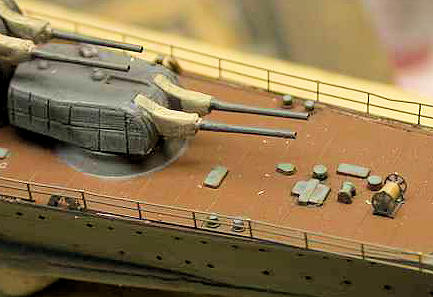 set
so complete that they make a marked improvement. I especially liked the etched
boarding lines.
set
so complete that they make a marked improvement. I especially liked the etched
boarding lines.
The
masts were built from conically turned brass from BMK, using the kit parts as
templates. The yards are made from fine brass wire, glued with CA glue. The main
railing from GMM are coarser than more recent products, yet they are easy to
work with and they did survive some inadvertent touching. Having aded all parts,
I checked and touched up the paintjob, added some weathering
and then a final flat clear coat.
The
model was rigged using stretched tan sprue for the signal lines, and two sizes
of
UNI
flyfishing thread for the standing rigging and antennae. The stays and
other larger diameter lines were made from 8/0 line, and the ultrafine Caenis
line was used for the rest. White glue was used, and heat from a dental waxing
instrument tightened the lines. The ensign is a kit decal which was carefully
wrapped around a piece of household aluminum foil. The crew figures are Lion
Roar items, attached with CA glue. A final flat coat completed work at the ship.
Finally,
the ship was mounted to the base using artist´s clear acrylic gel.
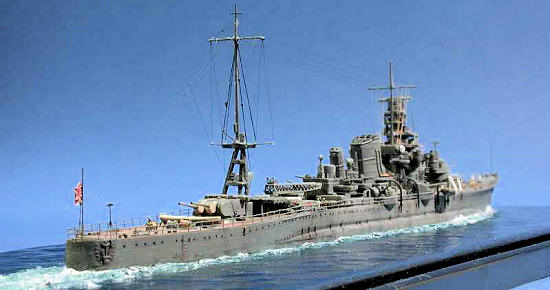 A
fine kit of an elegant vessel with lots of possibilities for detailing to
whichever extent you enjoy it.
A
fine kit of an elegant vessel with lots of possibilities for detailing to
whichever extent you enjoy it.
Frank Spahr
August 2010
If you would like your product reviewed fairly and quickly, please
contact
me or see other details in the
Note to
Contributors.
Back to the Main Page
Back to the Review
Index Page


 new
machinery, torpedo bulges plus similar twin turrets for the main armament as her
later sisters. The aircraft hangar was removed, rotating torpedo launchers were
fitted, and the AA fit was augmented.
new
machinery, torpedo bulges plus similar twin turrets for the main armament as her
later sisters. The aircraft hangar was removed, rotating torpedo launchers were
fitted, and the AA fit was augmented. the
cranes and catapults mark the limits of injected plastic technology; replacing
them with items from today´s extensive aftermarket will visibly improve the
model´s overall impression. I for one do not use aftermarket items just for the
sake of using them, but only if I see an improvement over the kit part.
the
cranes and catapults mark the limits of injected plastic technology; replacing
them with items from today´s extensive aftermarket will visibly improve the
model´s overall impression. I for one do not use aftermarket items just for the
sake of using them, but only if I see an improvement over the kit part. was very
simple, with Kure Grey over all, save the linoleum-coated decks. I used JPS
acrylics which spray and brush equally nicely and are easily touched up. To
highlight hull details, an oil wash was used. For the wash, I mix artist´s oil
paints and Humbrol thinner – this mixture works fine and does not harm my
acrylics. Some gentle drybrushing with grey oil paint further accentuated
details. I also used this paint to highlight the fastening strips for the
linoleum decks. Even though they were made from brass, I wouldn´t want to
use brass paint in this small scale.
was very
simple, with Kure Grey over all, save the linoleum-coated decks. I used JPS
acrylics which spray and brush equally nicely and are easily touched up. To
highlight hull details, an oil wash was used. For the wash, I mix artist´s oil
paints and Humbrol thinner – this mixture works fine and does not harm my
acrylics. Some gentle drybrushing with grey oil paint further accentuated
details. I also used this paint to highlight the fastening strips for the
linoleum decks. Even though they were made from brass, I wouldn´t want to
use brass paint in this small scale.

 hip´s
boats and AA guns were taken from the generic equipment sprue of the Waterline
series. Properly painted they looked quite all right to me. I skipped the
seaplanes. One of Kako´s planes had been lost prior to the battle, the other had
been landed at the eve of the battle. I just added spare floats and wings which
are stored at the funnel and near the flight deck. Their green and brown camo
scheme offers some welcome contrast to the overall grey scheme.
hip´s
boats and AA guns were taken from the generic equipment sprue of the Waterline
series. Properly painted they looked quite all right to me. I skipped the
seaplanes. One of Kako´s planes had been lost prior to the battle, the other had
been landed at the eve of the battle. I just added spare floats and wings which
are stored at the funnel and near the flight deck. Their green and brown camo
scheme offers some welcome contrast to the overall grey scheme. 
